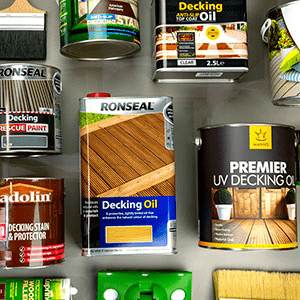Wood Preserver FAQ's
Do I need to use a wood preserver when oiling exterior wood?
While you can oil exterior wood without using a preservative first, we recommend using a wood preservative. Whilst wood oils protect against the effects of weathering, rain and sun damage, a preserver will protect the wood against mould, algae, wood boring insects and rot, elements that a wood oil alone cannot protect against.
Can I paint over wood that has been treated with a wood preservative?
This depends on what sort of preservative and what sort of paint is being used. Normal tanalised wood for example can usually be painted with any suitable exterior wood paint. If the wood is to be treated with an exterior wood preservative, then painted with a water based exterior wood paint, it's important to ensure that the wood preservative being used does not contain any wax, oil or silicon, as these will repel the water content of the paint and prevent it from sticking or adhering to the wood. We recommend that when preserving and painting wood, a test area is treated first to check product suitability and compatibility.
Will a coloured wood preservative produce the same colour finish on my old fence panels and newly replaced panels?
The colour on the new fence panels is unlikely to match the colour of the old panels even when treated with the same product. Unfortunately, this is the nature of wood. Every piece of wood is affected by type, age and condition and will respond differently when a wood finishing product such as a coloured wood preservative is applied. If the older panels appear to be a lighter colour than the new treated ones, an additional coat of preservative can be applied to the older panels to strengthen the colour and achieve a better colour match to the new or vice versa. The colour of newly applied preservative will settle down after a couple of weeks of weathering.
Can wood preservatives be used to preserve animal enclosures?
The wood preservers we sell are safe for man, animal and plants when fully dry. This makes them suitable for use on dog kennels, horse stables and other animal enclosures. By their nature, wood preservatives are designed to protect wood from wood boring insects so are therefore not suitable for use on beehives or insect houses. if you would like to protect your beehive or insect house choose a product without biocides and insecticides.
I need advise on how to treat woodworm?
Active woodworm needs to be treated with a woodworm killer. The wood should then be treated with a suitable interior or exterior wood preservative which will help to prevent future infestation. See our full range of woodworm treatment products and wood preservatives. Wood that has been finished such as furniture, floorboards and doors should be stripped of any wax, oil, varnish or paint to ensure that the woodworm treatment and following preservative is able to effectively penetrate in to the surface of the wood grain. If you want to use a water based paint over a preservative use one that does not contain wax.
What is the best preserver for a plywood gate?
This really depends on what you're going to be finishing it with. If you're going to be using a wood paint or a wood oil, you're better off using Barrettine Premier Universal Preserver or Sadolin Quick Drying Wood Preserver which are compatible with most types of top coats.
If you want an all-in-one product which colours, seals and protects, then products such as Barrettine Premier Wood Preserver, Ronseal Total Wood Preservative or Cuprinol Ultimate Garden Wood Preserver will do all of the above. Alternatively, see our wood preservative treatments page for more information.
How do I remove Creocote from my wooden bench?
Unfortunately this will be quite difficult to remove as the Creocote dries by absorption into the wood, rather than by forming a film, so may transfer for some time.
If the application was recent, it may be possible to remove the worst by wiping down thoroughly with white spirit and plenty of rags. However, the colour will not be removed and there will still be some risk of transference.
However, once the bench has thoroughly dried then it should be possible to seal in the remaining Creocote with a solvent-based product such as Barrettine Premier Wood Preserver in Clear or Coloured. Barrettine Decking Oil in Clear would also be suitable, but the coloured versions of this would not be.
I have bought shed and fence preserver --- it says allow 24 hrs to recoat but what is the drying time in case of showery weather?
Our best recommendation is to apply in a period of time that ensures the weather is dry for the required drying and curing time of application. Of course the British weather is some what unpredictable and should a light show occur it is unlikely to cause too many problems. Some milkiness may occur and this will more often than not disperse on its own with some warm weather.
For application of further coats, should it rain in between coats, you may need to allow the wood to dry for 24 hours before the next coat. Again waiting for a period of dry weather to avoid delay between coats is the best option.
Can a wood preservative be used on wood surrounding a fish pond?
Wood preservatives are harmful to aquatic systems such as fish ponds and will likely kill the fish if any is splashed or leaks in to the fish pond. If possible, the wood should be taken to a safe location away from the pond and treated. It should then be allowed to dry for the full manufacturers recommended drying time. We recommend treating the wood after preserving with a suitable exterior wood oil before relocating back to the pond areas. The oil will help to seal in the preservative and further protect the wood from the damp and moist environment.
I started painting the inside of a cabin with a golden oak coloured preservative and am not keen on the colour. I want to use another colour. Do I paint over what I have done or can I strip the preserver off? It's only been done in last 2 hours. I want to use Cuprinol shades.
Check to see if the preserver contains any wax or not. If it did, you won't be able to apply the Cuprinol Garden Shades directly over the top as the wax in the preserver will repel the water-based garden shades. If the preserver was 'wax free' and has fully dried, baring in mind the colour difference that this may produce, you should be able to paint over the area treated with the preserver with the garden shades paint.
If the preservative used was a solvent-based preserver and contained wax, you may be able to soak and scrub the wax and some if not most of the colour out using methylated spirit and a clean absorbent cloth. The cloth should be white or uncoloured, otherwise the methylated spirit may cause any colour in the cloth to transfer to the wood.
It is for this reason that we always recommend doing a test area to assess a products suitability and final finish before starting any project.
Wood Preservative related blog posts
- 5 Top Wood Preservers to Protect and Serve
- Product Focus: Barrettine Wood Preservatives
- How To Preserve a Fence Panel So it Will Last! - Ronseal Total Wood Preserver.
Disclaimer: Whilst every attempt has been made to provide product information that is as accurate as possible, it's important to clarify that trees and the wood that they produce can be affected by many factors. For example, the same species of tree grown in the same wood, even in close proximity, will be affected by age along with the amount of sunlight and water they receive. Other naturally occurring biological and environmental factors will also influence the density and grain of the wood as well as the moisture and oil content of the timber. No two trees are the same, meaning each piece of wood has the potential to look and react differently to the same wood finish. For example, product adhesion, colour variations, absorption rates and sheen levels. It is for this reason that we always strongly recommend carrying out test areas before starting any project


